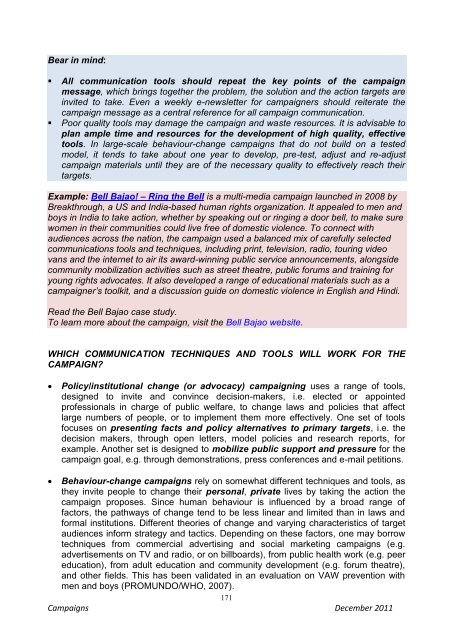Campaigns to End Violence against Women and Girls - Virtual ...
Campaigns to End Violence against Women and Girls - Virtual ...
Campaigns to End Violence against Women and Girls - Virtual ...
Create successful ePaper yourself
Turn your PDF publications into a flip-book with our unique Google optimized e-Paper software.
Bear in mind:<br />
� All communication <strong>to</strong>ols should repeat the key points of the campaign<br />
message, which brings <strong>to</strong>gether the problem, the solution <strong>and</strong> the action targets are<br />
invited <strong>to</strong> take. Even a weekly e-newsletter for campaigners should reiterate the<br />
campaign message as a central reference for all campaign communication.<br />
� Poor quality <strong>to</strong>ols may damage the campaign <strong>and</strong> waste resources. It is advisable <strong>to</strong><br />
plan ample time <strong>and</strong> resources for the development of high quality, effective<br />
<strong>to</strong>ols. In large-scale behaviour-change campaigns that do not build on a tested<br />
model, it tends <strong>to</strong> take about one year <strong>to</strong> develop, pre-test, adjust <strong>and</strong> re-adjust<br />
campaign materials until they are of the necessary quality <strong>to</strong> effectively reach their<br />
targets.<br />
Example: Bell Bajao! – Ring the Bell is a multi-media campaign launched in 2008 by<br />
Breakthrough, a US <strong>and</strong> India-based human rights organization. It appealed <strong>to</strong> men <strong>and</strong><br />
boys in India <strong>to</strong> take action, whether by speaking out or ringing a door bell, <strong>to</strong> make sure<br />
women in their communities could live free of domestic violence. To connect with<br />
audiences across the nation, the campaign used a balanced mix of carefully selected<br />
communications <strong>to</strong>ols <strong>and</strong> techniques, including print, television, radio, <strong>to</strong>uring video<br />
vans <strong>and</strong> the internet <strong>to</strong> air its award-winning public service announcements, alongside<br />
community mobilization activities such as street theatre, public forums <strong>and</strong> training for<br />
young rights advocates. It also developed a range of educational materials such as a<br />
campaigner’s <strong>to</strong>olkit, <strong>and</strong> a discussion guide on domestic violence in English <strong>and</strong> Hindi.<br />
Read the Bell Bajao case study.<br />
To learn more about the campaign, visit the Bell Bajao website.<br />
WHICH COMMUNICATION TECHNIQUES AND TOOLS WILL WORK FOR THE<br />
CAMPAIGN?<br />
� Policy/institutional change (or advocacy) campaigning uses a range of <strong>to</strong>ols,<br />
designed <strong>to</strong> invite <strong>and</strong> convince decision-makers, i.e. elected or appointed<br />
professionals in charge of public welfare, <strong>to</strong> change laws <strong>and</strong> policies that affect<br />
large numbers of people, or <strong>to</strong> implement them more effectively. One set of <strong>to</strong>ols<br />
focuses on presenting facts <strong>and</strong> policy alternatives <strong>to</strong> primary targets, i.e. the<br />
decision makers, through open letters, model policies <strong>and</strong> research reports, for<br />
example. Another set is designed <strong>to</strong> mobilize public support <strong>and</strong> pressure for the<br />
campaign goal, e.g. through demonstrations, press conferences <strong>and</strong> e-mail petitions.<br />
� Behaviour-change campaigns rely on somewhat different techniques <strong>and</strong> <strong>to</strong>ols, as<br />
they invite people <strong>to</strong> change their personal, private lives by taking the action the<br />
campaign proposes. Since human behaviour is influenced by a broad range of<br />
fac<strong>to</strong>rs, the pathways of change tend <strong>to</strong> be less linear <strong>and</strong> limited than in laws <strong>and</strong><br />
formal institutions. Different theories of change <strong>and</strong> varying characteristics of target<br />
audiences inform strategy <strong>and</strong> tactics. Depending on these fac<strong>to</strong>rs, one may borrow<br />
techniques from commercial advertising <strong>and</strong> social marketing campaigns (e.g.<br />
advertisements on TV <strong>and</strong> radio, or on billboards), from public health work (e.g. peer<br />
education), from adult education <strong>and</strong> community development (e.g. forum theatre),<br />
<strong>and</strong> other fields. This has been validated in an evaluation on VAW prevention with<br />
men <strong>and</strong> boys (PROMUNDO/WHO, 2007).<br />
171<br />
<strong>Campaigns</strong> December 2011










